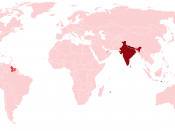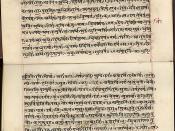The movie" Legacy India" and chapter three Hinduism of the book Living religion by Mary Pat Fisher describe Hinduism as Santana dharma, the eternal tradition or religion. This refers to the idea that its origins lie beyond human history, and its truths have been divinely revealed and passed down through the ages to the present day in the most ancient of the world's scriptures, the Veda. Many share this faith perspective, but various differing views arise when it comes to interpreting human history in early India. The movie" Legacy India" portrays a popular view today among some Hindus -- particularly those who are often referred to as Hindu nationalists, owing to their belief that Hinduism is India's true religion -- is that divine truth was revealed to the Aryans, whom they see as the noble, enlightened race which lived in India thousands of years ago. The Aryans shared a great language, Sanskrit, in which the Vedic scriptures were composed, and built a majestic Hindu civilization, the rituals, literature, and law of which remain the common culture of Hindus today and India's rightful national heritage.
According to this view, people belonging to the religions which developed in India after the time of the Aryans, like Buddhists, Jains, and Sikhs, are all embraced as part of the Hindu religion. But many Hindus, as well as Buddhists, Jains, and Sikhs themselves, do not share this understanding. They challenge the idea that the roots of Hinduism were entirely Aryan. They believe instead that some of the great deities and important religious developments that we now associate with Hinduism came from indigenous people who lived in India before the Aryans.
Hinduism is not defined so much by its spiritual and philosophical traditions as by its worldliness, its focus on the things of this world like the acquisition of wealth and love and the practice of duty. The ritual, devotional, and social practices of the followers of Krishna, Shiva, and the Goddess have too often been ignored in Western accounts. An important aspect of Hinduism is power. Its adherents are concerned with seeking divine assistance in order to acquire and use this power for desired ends and rewards.
Comparing Hinduism to Christianity, Mary Pat Fisher tells that it does indeed have a God -- one ultimate reality and many gods and goddesses, in fact. But it has no founder, a multitude of scriptures rather than one book, Brahmins but no priests in the Christian sense, and no central institution like a church. Ritual, myth, and ethics are important, but belief is of less significance, there being no core creed and few common teachings. But there might also be things intrinsic to Hinduism that just doesn't show up in a comparison with Christianity. For example, Hinduism extends into the complex socio-religious system of caste and the varied popular practices which, in Christian terms, constitute magic and superstition rather than religion. So, if Hinduism is a religion at all, it is a rather different one to Christianity, if the latter is to be the benchmark for religion.
According to Mary Pat Fisher the meaning and validity of 'Hinduism' has been much discussed as knowledge of its origins has grown. But more than anything, it is awareness of the internal complexity of 'Hinduism' which has called the term into question. Not only does it comprise the major divisions of Vaishnavism, Shaivism, and Shaktism, but it also offers a variety of different philosophical approaches, thousands of deities and their associated mythology and iconography, and innumerable ritual practices.
ReferencesFisher P. Mary, (July 30, 2002), Living religion, Prentice Hall; 5 edition, 512 pages, ISBN-10: 0130992283, ISBN-13: 978-0130992284





